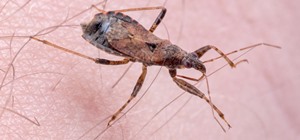At a global security conference in Munich, philanthropist and businessman Bill Gates spoke about the next pandemic and a dire lack of global readiness. Here's how his statement could come true—and how to be ready when it does.
On Saturday, Bill Gates joined hundreds of heads-of-state, decision makers, academics, and experts, at the annual Munich Security Conference, a global forum that has focused on security policy for more than 50 years.
During a panel discussion, Gates spoke plainly:
Whether it occurs by the quirk of nature or the hand of the terrorist, epidemiologists showed through their models that a respiratory-spread pathogen would kill more than 30 million people in less than a year. There is a reasonable probability of that taking place in years ahead.
Although a high-profile entrepreneur, Gates is no newcomer to global health issues. Launched in 2000, the Bill and Melinda Gates Foundation is a private organization that invests in key developmental areas aimed at reducing global poverty and improving health.
In January, Gates announced the formation of the Coalition for Epidemic Preparedness Innovations (CEPI), a global organization partially supported by his foundation, to put structure and vaccines in place for the next global health emergency.

In a 2015 article in the New England Journal of Medicine, Gates noted our lack of readiness to cope with an epidemic like Ebola, where many lives were lost because the worldwide capability to respond effectively did not exist. Gates wrote in the article: "The problem is not the fault of any single institution—it reflects a global failure."
When Gates talks about risk and readiness, what can you take away from that?
Living with Risk of Bioterrorism
There are a number of pathogens with the capability to cause worldwide impact if used as weapons. According to the Centers for Disease Control and Prevention (CDC), those agents, which spread—or could be spread—through different methods, currently include:
- Anthrax: Easily spread through contact or inhalation, anthrax bacteria release toxins in the body that can be fatal. Anthrax does not spread person-to-person like flu or cold viruses.
- Brucellosis: This bacteria spreads through contaminated meats and unpasteurized milk products, as well as breathing in the bacteria in heavily laden air, such as a slaughterhouse or laboratory. The infection can be treated with antibiotics and fatalities are rare.
- Botulism: The bacteria Clostridium botulinum and related strains produce a toxin that can be spread through eating contaminated foods, exposure to intestinal spores, or overdose of the toxin. Botulism is fatal without urgent medical care.
- Plague: The bacteria that causes a pneumonic type of plague, Yersinia pestis, could be aerosolized to expose a large group. Because the lung infection incubates for up to six days, those exposed could infect others through breathing, coughing, sneezing. If caught within seven days, plague can be treated with a full course of antibiotics, otherwise this disease is often fatal.
- Smallpox: Though considered eradicated, the appearance of even one smallpox case would be considered an emergency. Labs in the US and Russia maintain the virus for research purposes. There is credible past concern that the virus could have been taken for storage elsewhere. The virus is spread by air through cough, sneeze, or secretion. There is a vaccination for smallpox, but the vaccine does not confer lifelong immunity and those born before 1972 are likely not protected against the virus.
- Tularemia: A bacteria found commonly in rodents and rabbits, Francisella tularensis is highly infectious and could be aerosolized as a weapon to infect many people. Tularemia causes potentially fatal lung and other infections that are often fatal without treatment. Tularemia has not been seen to spread from person to person, and can be treated with antibiotics.
- Viral hemorrhagic fevers (including viruses like Ebola): Viral hemorrhagic fevers are highly infectious and cause severe, if not fatal, illness. Added to their ability to spread from person to person, these viruses, including yellow fever viruses, Ebola, Marburg, Rift Valley, and Junin fever, were classified as a potential bioweapon in 1999.
This list only mentions known highly contagious pathogens. It is reasonable to consider a highly fatal infectious agent could be genetically engineered, or combined with another toxin, to create an unknown bioweapon. Concern about bioweaponry is appropriate. If such a pathogen is released, it cannot be retrieved, and it is possible it might evade control or treatment. Sure, it is a scare factor, but a real one.
Discussing surveillance to identify an emergent epidemic or pandemic, in Munich, Gates noted, "Rwanda is a leader, if an epidemic started there, we'd see it quickly." For terrorists, the choice of weaponry likely depends on the type of impact desired. A bioweapon might be used in highly populated areas, where other types of weapons, like a radioactive dirty bomb, might be directed at infrastructure like the electrical grid, transportation, and water treatment facilities.
Response to an outbreak of any kind occurs at an agency (global, federal, or state) and personal level. During an outbreak, understanding the danger is difficult at first. The Ebola outbreak offered a first-hand look at the panic and unpreparedness associated with a pandemic.

In his multiple warnings, Gates highlights the need for experts of many kinds, vaccines, communication infrastructure, and much more. In Munich, Gates stated, "Who's this alternate group that's going to deal with the panic? Who's got the planes and the budget? Maybe the fire department?"
The response to Ebola was ultimately effective, but lives were lost, and mistakes and missed opportunities for better management were plentiful.
Steps You Can Take Toward Readiness
We live in a time where personal readiness is important in many ways. There is no denying that you need to know how to handle yourself in the event of an active shooter. It makes sense to take steps to keep yourself and family safe in the event of an outbreak or other emergency.
Readiness means planning for the unexpected. For any kind of disaster that means provisions, planning, and information. Consider these tips:
- Provisions: Emergency kits have been recommended since the days of sheltering under school desks in preparation for an atomic bomb. Whether the disaster is natural or an attack, it is essential to have supplies on hand. Some people feel the need to build a bunker in the county and stock it, while others are good with grab-and-go bags for evacuation, or supplies maintained in a closet for sheltering in place. Since you cannot know what type of pathogen is circulating, sheltering in place could easily be the recommendation. There are many resources available, and kits you can purchase. Be careful to fine-tune your supplies to include important medications, identification papers, the capability to charge electronic devices, and more.
- Plan: When you fly, you are consistently told to look for the nearest emergency exit. You will hopefully never need to use that exit, but you have a plan in mind. The same goes with any kind of disaster, or pandemic. Plan with family and friends what you will do in case of emergency. Your plan must be fluid, with contacts outside your region, and on social media, to get and give information. Generally, you need to know where, and how, to meet the people you need to be with. Then, depending on the actual risk and potential threat, you go from there.
- Communication: In a pandemic situation, accurate, fact-based information is critical to appropriate response, and even survival. If you live in a city, fleeing in panic could expose you to the pathogens you sought to avoid. Keep a radio with fresh batteries and investigate non-electric chargers for your devices.
- Give a hand: Consider training for your local Community Emergency Response Team (CERT). The training gives you a greater perspective on readiness, provides important safety background, and gives you basic medical, search and rescue, and other organizational skills to help your family and your community in the event of any type of disaster.
As a global community, there is little disagreement that we are unprepared for an emergent, or intentional, pandemic. We live in an age of advanced weaponry and an abundance of ill will. Readiness does not require panic, it means taking the effort, on whatever level you choose or are qualified, to plan for the unexpected.
Just updated your iPhone? You'll find new emoji, enhanced security, podcast transcripts, Apple Cash virtual numbers, and other useful features. There are even new additions hidden within Safari. Find out what's new and changed on your iPhone with the iOS 17.4 update.



























Be the First to Comment
Share Your Thoughts